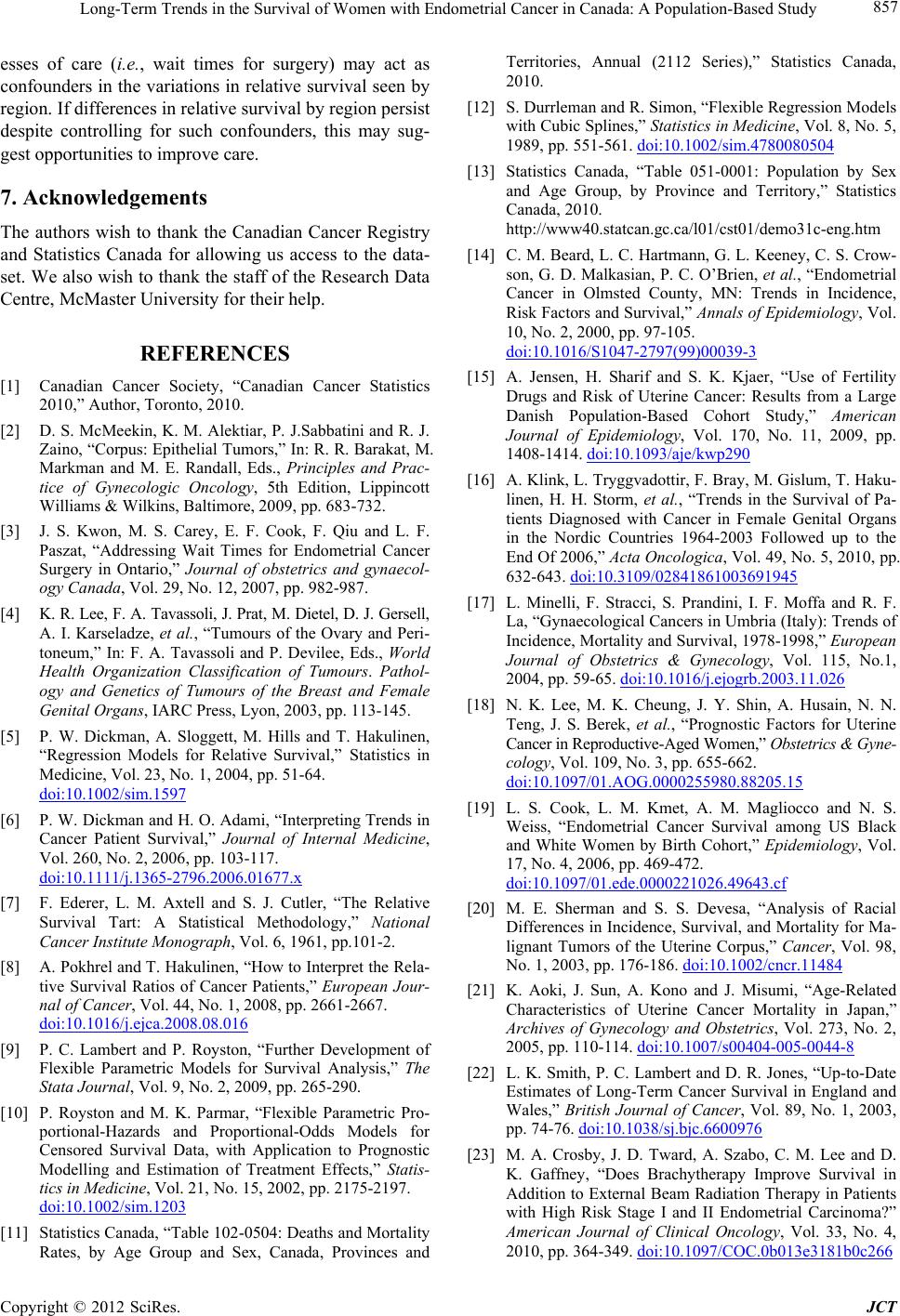
Long-Term Trends in the Survival of Women with Endometrial Cancer in Canada: A Population-Based Study 857
esses of care (i.e., wait times for surgery) may act as
confounders in the variations in relative survival seen by
region. If differences in relative survival by region persist
despite controlling for such confounders, this may sug-
gest opportunities to improve care.
7. Acknowledgements
The authors wish to thank the Canadian Cancer Registry
and Statistics Canada for allowing us access to the data-
set. We also wish to thank the staff of the Research Data
Centre, McMaster University for their help.
REFERENCES
[1] Canadian Cancer Society, “Canadian Cancer Statistics
2010,” Author, Toronto, 2010.
[2] D. S. McMeekin, K. M. Alektiar, P. J.Sabbatini and R. J.
Zaino, “Corpus: Epithelial Tumors,” In: R. R. Barakat, M.
Markman and M. E. Randall, Eds., Principles and Prac-
tice of Gynecologic Oncology, 5th Edition, Lippincott
Williams & Wilkins, Baltimore, 2009, pp. 683-732.
[3] J. S. Kwon, M. S. Carey, E. F. Cook, F. Qiu and L. F.
Paszat, “Addressing Wait Times for Endometrial Cancer
Surgery in Ontario,” Journal of obstetrics and gynaecol-
ogy Canada, Vol. 29, No. 12, 2007, pp. 982-987.
[4] K. R. Lee, F. A. Tavassoli, J. Prat, M. Dietel, D. J. Gersell,
A. I. Karseladze, et al., “Tumours of the Ovary and Peri-
toneum,” In: F. A. Tavassoli and P. Devilee, Eds., World
Health Organization Classification of Tumours. Pathol-
ogy and Genetics of Tumours of the Breast and Female
Genital Organs, IARC Press, Lyon, 2003, pp. 113-145.
[5] P. W. Dickman, A. Sloggett, M. Hills and T. Hakulinen,
“Regression Models for Relative Survival,” Statistics in
Medicine, Vol. 23, No. 1, 2004, pp. 51-64.
doi:10.1002/sim.1597
[6] P. W. Dickman and H. O. Adami, “Interpreting Trends in
Cancer Patient Survival,” Journal of Internal Medicine,
Vol. 260, No. 2, 2006, pp. 103-117.
doi:10.1111/j.1365-2796.2006.01677.x
[7] F. Ederer, L. M. Axtell and S. J. Cutler, “The Relative
Survival Tart: A Statistical Methodology,” National
Cancer Institute Monograph, Vol. 6, 1961, pp.101-2.
[8] A. Pokhrel and T. Hakulinen, “How to Interpret the Rela-
tive Survival Ratios of Cancer Patients,” European Jour-
nal of Cancer, Vol. 44, No. 1, 2008, pp. 2661-2667.
doi:10.1016/j.ejca.2008.08.016
[9] P. C. Lambert and P. Royston, “Further Development of
Flexible Parametric Models for Survival Analysis,” The
Stata Journal, Vol. 9, No. 2, 2009, pp. 265-290.
[10] P. Royston and M. K. Parmar, “Flexible Parametric Pro-
portional-Hazards and Proportional-Odds Models for
Censored Survival Data, with Application to Prognostic
Modelling and Estimation of Treatment Effects,” Statis-
tics in Medicine, Vol. 21, No. 15, 2002, pp. 2175-2197.
doi:10.1002/sim.1203
[11] Statistics Canada, “Table 102-0504: Deaths and Mortality
Rates, by Age Group and Sex, Canada, Provinces and
Territories, Annual (2112 Series),” Statistics Canada,
2010.
[12] S. Durrleman and R. Simon, “Flexible Regression Models
with Cubic Splines,” Statistics in Medicine, Vol. 8, No. 5,
1989, pp. 551-561. doi:10.1002/sim.4780080504
[13] Statistics Canada, “Table 051-0001: Population by Sex
and Age Group, by Province and Territory,” Statistics
Canada, 2010.
http://www40.statcan.gc.ca/l01/cst01/demo31c-eng.htm
[14] C. M. Beard, L. C. Hartmann, G. L. Keeney, C. S. Crow-
son, G. D. Malkasian, P. C. O’Brien, et al., “Endometrial
Cancer in Olmsted County, MN: Trends in Incidence,
Risk Factors and Survival,” Annals of Epidemiology, Vol.
10, No. 2, 2000, pp. 97-105.
doi:10.1016/S1047-2797(99)00039-3
[15] A. Jensen, H. Sharif and S. K. Kjaer, “Use of Fertility
Drugs and Risk of Uterine Cancer: Results from a Large
Danish Population-Based Cohort Study,” American
Journal of Epidemiology, Vol. 170, No. 11, 2009, pp.
1408-1414. doi:10.1093/aje/kwp290
[16] A. Klink, L. Tryggvadottir, F. Bray, M. Gislum, T. Haku-
linen, H. H. Storm, et al., “Trends in the Survival of Pa-
tients Diagnosed with Cancer in Female Genital Organs
in the Nordic Countries 1964-2003 Followed up to the
End Of 2006,” Acta Oncologica, Vol. 49, No. 5, 2010, pp.
632-643. doi:10.3109/02841861003691945
[17] L. Minelli, F. Stracci, S. Prandini, I. F. Moffa and R. F.
La, “Gynaecological Cancers in Umbria (Italy): Trends of
Incidence, Mortality and Survival, 1978-1998,” European
Journal of Obstetrics & Gynecology, Vol. 115, No.1,
2004, pp. 59-65. doi:10.1016/j.ejogrb.2003.11.026
[18] N. K. Lee, M. K. Cheung, J. Y. Shin, A. Husain, N. N.
Teng, J. S. Berek, et al., “Prognostic Factors for Uterine
Cancer in Reproductive-Aged Women,” Obstetrics & Gyne-
cology, Vol. 109, No. 3, pp. 655-662.
doi:10.1097/01.AOG.0000255980.88205.15
[19] L. S. Cook, L. M. Kmet, A. M. Magliocco and N. S.
Weiss, “Endometrial Cancer Survival among US Black
and White Women by Birth Cohort,” Epidemiology, Vol.
17, No. 4, 2006, pp. 469-472.
doi:10.1097/01.ede.0000221026.49643.cf
[20] M. E. Sherman and S. S. Devesa, “Analysis of Racial
Differences in Incidence, Survival, and Mortality for Ma-
lignant Tumors of the Uterine Corpus,” Cancer, Vol. 98,
No. 1, 2003, pp. 176-186. doi:10.1002/cncr.11484
[21] K. Aoki, J. Sun, A. Kono and J. Misumi, “Age-Related
Characteristics of Uterine Cancer Mortality in Japan,”
Archives of Gynecology and Obstetrics, Vol. 273, No. 2,
2005, pp. 110-114. doi:10.1007/s00404-005-0044-8
[22] L. K. Smith, P. C. Lambert and D. R. Jones, “Up-to-Date
Estimates of Long-Term Cancer Survival in England and
Wales,” British Journal of Cancer, Vol. 89, No. 1, 2003,
pp. 74-76. doi:10.1038/sj.bjc.6600976
[23] M. A. Crosby, J. D. Tward, A. Szabo, C. M. Lee and D.
K. Gaffney, “Does Brachytherapy Improve Survival in
Addition to External Beam Radiation Therapy in Patients
with High Risk Stage I and II Endometrial Carcinoma?”
American Journal of Clinical Oncology, Vol. 33, No. 4,
2010, pp. 364-349. doi:10.1097/COC.0b013e3181b0c266
Copyright © 2012 SciRes. JCT